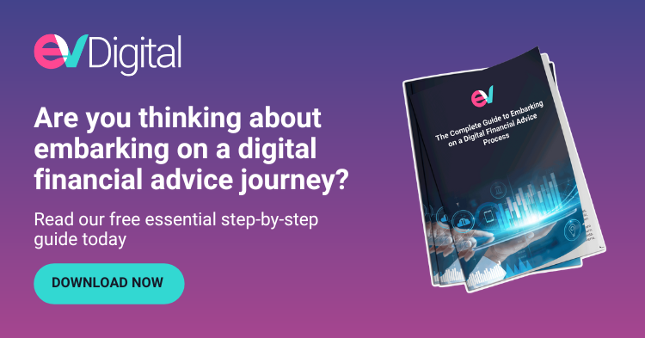Discover the One Forecast Method That Can Personalise Risk and Reward in Automated Financial Advice
%20(1).png)
In this article, we unpack what automated financial advice is and why you should adopt it, how you should use automated investment advice in your financial planning service and why you need to underpin your advice with realistic forecasting through a stochastic asset model.
With pressure to deliver affordable financial advice profitably, tackle rising costs and inject value into the advice process, more financial advice practices are looking at ways to utilise automation in the financial advice process. However, when utilising automation, we recommend underpinning automated advice with a realistic forecasting model to ensure your clients receive personalised risk and reward outcomes, leading to better investment outcomes.
What is automated financial advice and why you should adopt it
Automated financial advice is algorithm-driven online advice with no or reduced human contact. Removing the human from elements of the advice process through automated advice can reduce the cost to service clients, allowing wider coverage of clients and increased business returns.
A recent Statista report highlighted that assets under management in the automated financial advice segment are expected to show an annual growth rate of 16.05% resulting in a projected total amount of US$63.80bn (UK£51.48bn) by 2027, reinforcing the impact automated advice is having on the industry, and why firms should consider adopting it.
Using technology to automate the repetitive and time-consuming aspects of the advice process enables financial advice businesses to deliver more affordable and profitable advice. With the ability to deliver more efficient experiences for both advisers and their clients, businesses that automate not only can achieve cost savings but could also achieve higher client satisfaction and engagement rates by providing a more streamlined financial advice process.
How you should use automated investment advice in your financial planning services
Whilst automating financial advice processes has undeniable benefits for businesses, businesses often need help with this as it can be hard to know which areas to automate. Focusing on the correct areas is vital to avoid wasting time automating work that doesn’t bring your firm any benefits. For example, whilst computers are useful for remembering things and performing accurate calculations, they don’t have the capacity for emotion or communicating with clients, so, this aspect should remain with humans.
Therefore, by utilising automated financial advice, the solution can generate calculated answers in a streamlined advice process based on the client’s inputs, enabling you to reduce the time and effort used to create that advice. This also enables you to expand into more holistic advice with a human adviser should the need arise for the client.
It is important, however, to underpin advice with the right forecast method, as this directly impacts the accuracy of investment recommendations and clients' investment outcomes.
At EV, we use realistic forecasting delivered by our forward-looking stochastic model, which takes into account the uncertainty and variability of financial markets and helps to identify potential risks and opportunities for clients.
Use cases of automated financial advice
Dealing with existing clients who have simple needs
For clients that have simpler advice needs, automated financial advice can be used to provide tailored advice that meets the needs of the client. Using data and algorithms, automated financial advice can provide clients with personalised investment recommendations based on their financial situation, investment goals, and risk tolerance.
Providing value to clients at different life stages
Automated financial advice provides value to clients at different life stages by offering personalised investment advice and portfolio management services tailored to their unique needs and circumstances. For younger clients who are still building their wealth, automated advice can provide low-cost guidance on investment options that will help them get started with investing and begin to build their portfolios. However, when clients’ needs become more advanced later in life, such as creating a retirement plan or ensuring their portfolios are appropriately allocated for income generation, hybrid advice or adviser-led advice will be necessary (depending on the complexity of their advice needs).
Helping to drive leads into full advice for more complex advice needs
Whilst automation allows you to provide initial advice for simple needs, for clients whose needs aren’t fully met from entirely digital financial advice, these clients can be offered more extensive hybrid advice or traditional advice, depending on the complexity of their needs.
Providing advice to a wider range of clients due to lower costs
Because algorithms (not human advisers) generate the advice, automated financial advice can be less expensive than traditional methods. As a result of both reduced costs and preserved adviser time, this can enable a wider range of clients to receive advice because it can be more affordable.
Where automated financial advice can aid in the implementation of the end-to-end advisory process
Fact find and objective setting
Advanced financial advice software with automation capabilities helps remove many of the repetitive tasks associated with onboarding clients. For example, automated financial advice can produce pre-populated documentation and send it automatically to the client for a digital signature, triggering alerts to others in the business when it’s time to complete the next task.
Ongoing service
Once a client has been brought on, service reduces contact with the opportunity for further automation of advice processes. Setting up automated workflows can speed up client reviews without compromising on service quality, leading to better client and organisational outcomes.
Improve compliance
Automation can improve compliance in financial advice by reducing the risk of human error, increasing consistency in the advice provided, and facilitating the monitoring and reporting of compliance-related information. Automated systems can also be programmed to ensure that advice is given within the boundaries of regulatory guidelines, automatically generate compliance reports, and complete audit trails of adviser activities, ensuring your firm’s advice process remains compliant within the regulatory framework.
Personalised advice outcomes
Technology enables mass-market personalisation that is impossible at scale through human interaction, meaning that you can consider how the customer’s finances and goals can be met with guidance or a streamlined advice process. When underpinned by a robust forward-looking asset model, automated financial advice can also be personalised to your client’s specific investment goals and risk tolerance leading to better client outcomes.
Why you need to underpin your automated financial advice with the realistic stochastic forecast model

Whilst it is clear that automation aids the implementation of financial advice processes, another key consideration is to back up your automated advice with a realistic stochastic forecasting model. EV utilises the stochastic model to underpin their automated digital advice technology to provide clients with a range of possible future outcomes based on a number of factors, leading to personalised risk and reward outcomes and better overall investment outcomes for the client.
The stochastic model won’t produce one determined outcome, but instead, will produce a range of possible outcomes by running 1000s of economic scenarios that consider the vast array of potential future market scenarios. As a result, the stochastic forecasting model can help optimise risk and return, and ensure that an individual's portfolio remains aligned with their goals and risk preferences over time.
Ultimately, using the stochastic model to back up automated financial advice, will lead to more advanced and accurate forecasting, enabling clients to effectively plan their financial future.
Summary
As you can see, automated financial advice has numerous advantages for your customers and your organisation. However, it is important to underpin it with the stochastic model for personalised client risk and reward outcomes.
With EV’s digital and hybrid financial advice solution supported by the stochastic forecasting model, this can lead to better overall outcomes for your clients based on realistic client advice. 